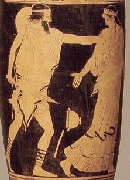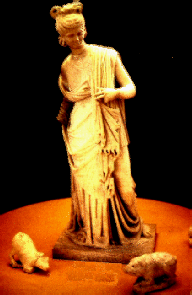Waldner, Katharina: Zwischen Kreta und Rom: Ovids Bearbeitung eines aitiologischen Mythos aus Nikanders Heteroiumena (Ant. Lib. 17) in den Metamorphosen (666 - 797), in: Römische Religion im historischen Wandel. Diskursentwicklung von Plautus bis Ovid. Hrsg. von Andreas Bendlin und Jörg Rüpke in Zusammenarbeit mit Diana Püschel, Stuttgart 2008, 171-186.
Wall, Kathleen: The Callisto myth from Ovid to Atwood: initiation and rape in literature. Kingston et al. 1988.
Walter, Hermann; Horn, Hans-Jürgen: Die Rezeption der Metamorphosen des Ovid in der Neuzeit. Der antike Mythos in Text und Bild. Berlin 1995.
Watkins, O.D.: Ovid, Metamorphoses, 8,375-8. Latomus 42 (1983) 135-138.
Wheeler, Stephen M.: Changing Names. The Miracle of Iphis in Ovid Metamorphoses 9. Phoenix 51 (1997) 190-202.
Wheeler, Stephen M.: A Discourse of Wonders: Audience and Performance in Ovid's Metamorphoses. Philadelphia 1999.
Wheeler, Stephen M.: Narrative Dynamics in Ovid's Metamorphoses. Tübingen 2000.
Wheeler, Stephen M.: Lucan's Reception of Ovid's Metamorphoses. Arehtusa 35 (2002) 361-380.
Wickkiser, Brownen L.: Famous Last Words: Putting Ovid's Sphragis Back into the Metamorphoses. MD 42 (1999) 113-142.
Wilkinson, L.P.: The World of the Metamorphoses. in: Ovidiana. Recherches sur Ovide. Publiées à l'occasion du bimillénaire de la naissance du poète par Nicolas I. Herescu. Paris 1958.
Williams, Frederick: Augustus and Daphne: Ovid, Metamorphoses 1,560-63 and Phylarchus FGrH 81 F 32 (b). PLLS 3 (1981) 249-257.
Williams, G.: Apollo, Aesculapius and the Poetics of Illness in Ovid's Metamorphoses, in: Health and Sickness in Ancient Rome. Greek and Roman Poetry and Historiography. Ed. by Francis Cairns and Miriam Griffin, Cambridge 2010, 63-92.
Williams, G.: The Metamorphoses: Politics and Narrative, in: A Companion to Ovid. Ed. by Peter E. Knox. Oxford 2009, 154-169.
Wimmel, Walter: Aglauros in Ovids Metamorphosen. Hermes 90 (1962) 326-333.
Wise, Valerie M.: Flight Myths in Ovid's Metamorphoses. An Interpretation of Phaethon and Daedalus. Ramus 6 (1977) 44-59.
Wissmer, Beat (Hrsg.): Diana und Actaeon - anlässlich der Ausstellung "Diana und Actaeon. Der verbotene Blick auf die Nacktheit", Museum Kunst Palast, Düsseldorf, 25. Oktober 2008 bis 15. Februar 2009, Ostfildern 2009.
Wrede, Henning: Augustus und das mythologische Landschaftsbild. KJ 24 (1991) 91-96.
Neil Wright: Creation and Recreation. Medieval responses to Metamorphoses 1.5-88. in: Ovidian Transformations. Essays on Ovid's Metamorphoses and its reception. Ed. by Philip Hardie, Alessandro Barchiesi, Stephen Hinds. Cambridge 1999 (Cambridge Philological Society Supp. Vol.23) 68-84.
Wülfing, Peter: Textlinguistics applied to the Metamorphosis of Ovid. in: Sprachen und Schriften des antiken Mittelmeerraums. Festschrift für Jürgen Untermann zum 65. Geburtstag. Hg. von Frank Heidermanns, Helmut Rix und Elmar Seebold. Innsbruck 1993. 473-481.
Wulff, Jutta: Die ovidische Daphne und ihre Rezeption in der englischen Literatur des 16. und 17. Jahrhunderts. Frankfurt et al. 1987 (Europäische Hochschulschriften 15,35).
Wyss, Beat: Pieter Bruegel, Landschaft mit Ikarussturz. Frankfurt, 1990.
Zaganiaris, N.J.: Le mythe de Terée dans la littérature grecque et latine. Platon 25 (1973). 208-232.
Zehnhacker, Hubert: Ovid et la tragédie. in: A Panellenio Sumposio Latiniken Spouden. Iannina 1984. 181-194.
Christian Zgoll: Phänomenologie der Metamorphose. Verwandlungen und Verwandtes in der augusteischen Dichtung. Tübingen 2004 (Classica Monacensia 28).
Andrew Zissos, Ingo Gildenhard: Problems of time in Metamorphoses 2. in: Ovidian Transformations. Essays on Ovid's Metamorphoses and its reception. Ed. by Philip Hardie, Alessandro Barchiesi, Stephen Hinds. Cambridge 1999 (Cambridge Philological Society Supp. Vol.23) 31-47.
Zumwalt, Nancy: Fama Subversa. Theme and Structure in Ovid Metamorphoses 12. CSCA 10 (1977). 209-222.
Zurli, L.: Locus Ovidianus (Met. VIII 371) nuperrime restitutus. GIF 53 (2001) 91-100.


